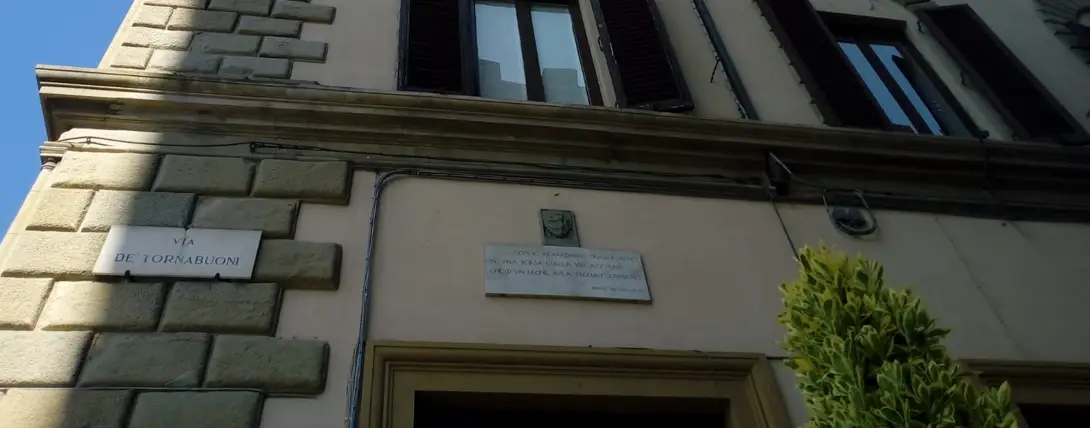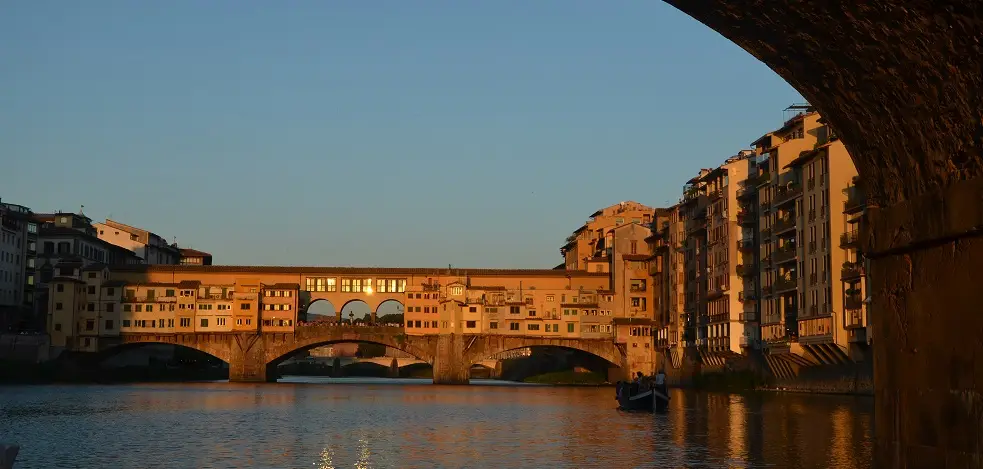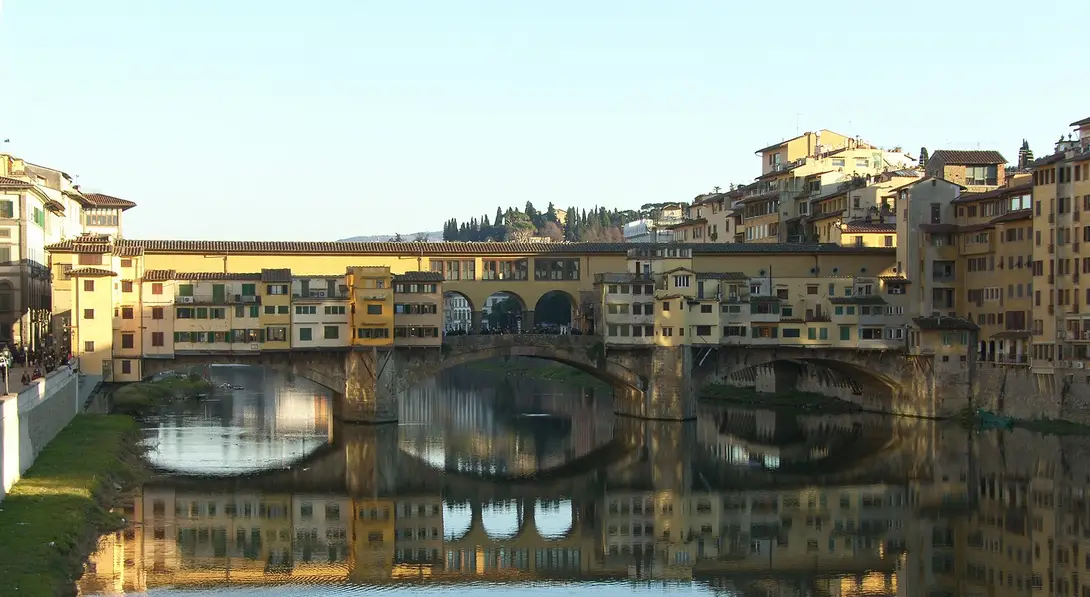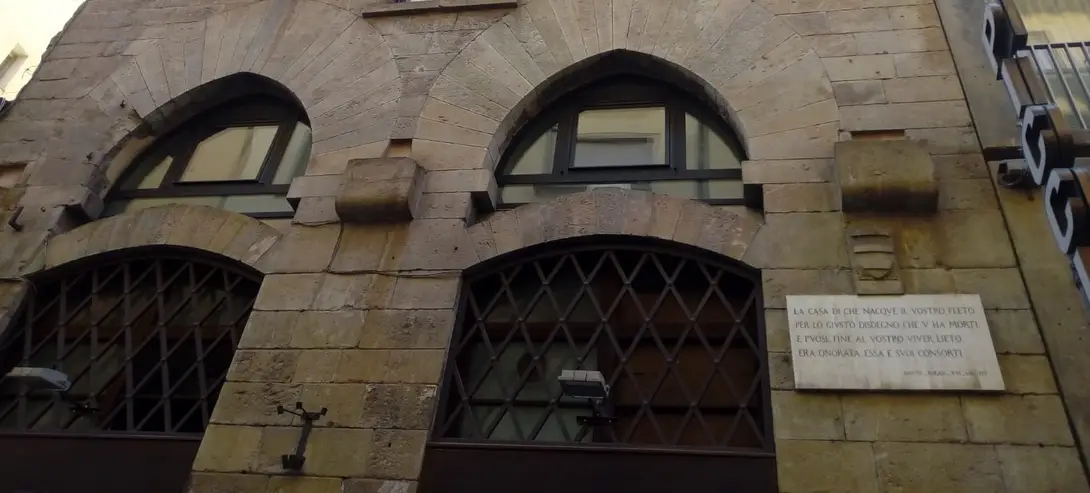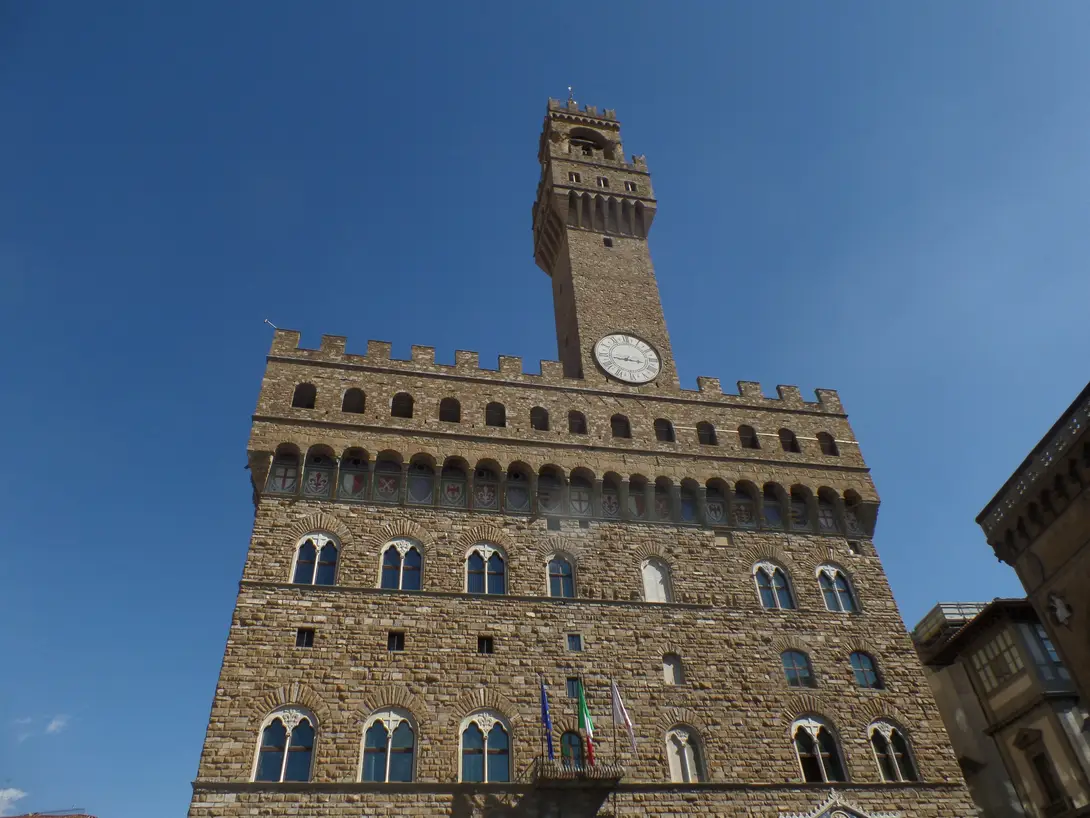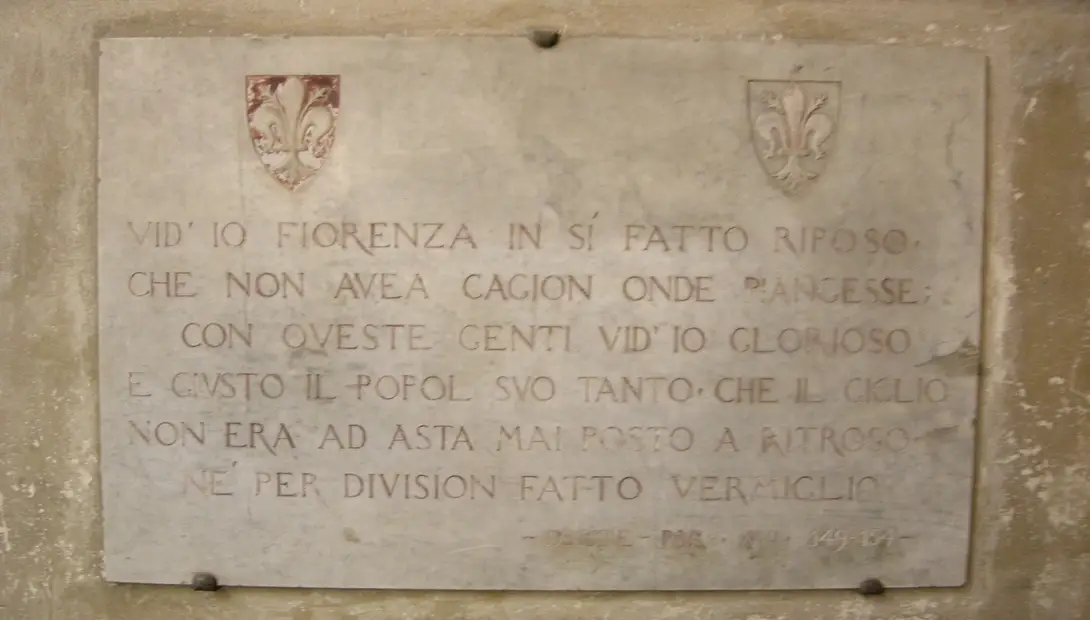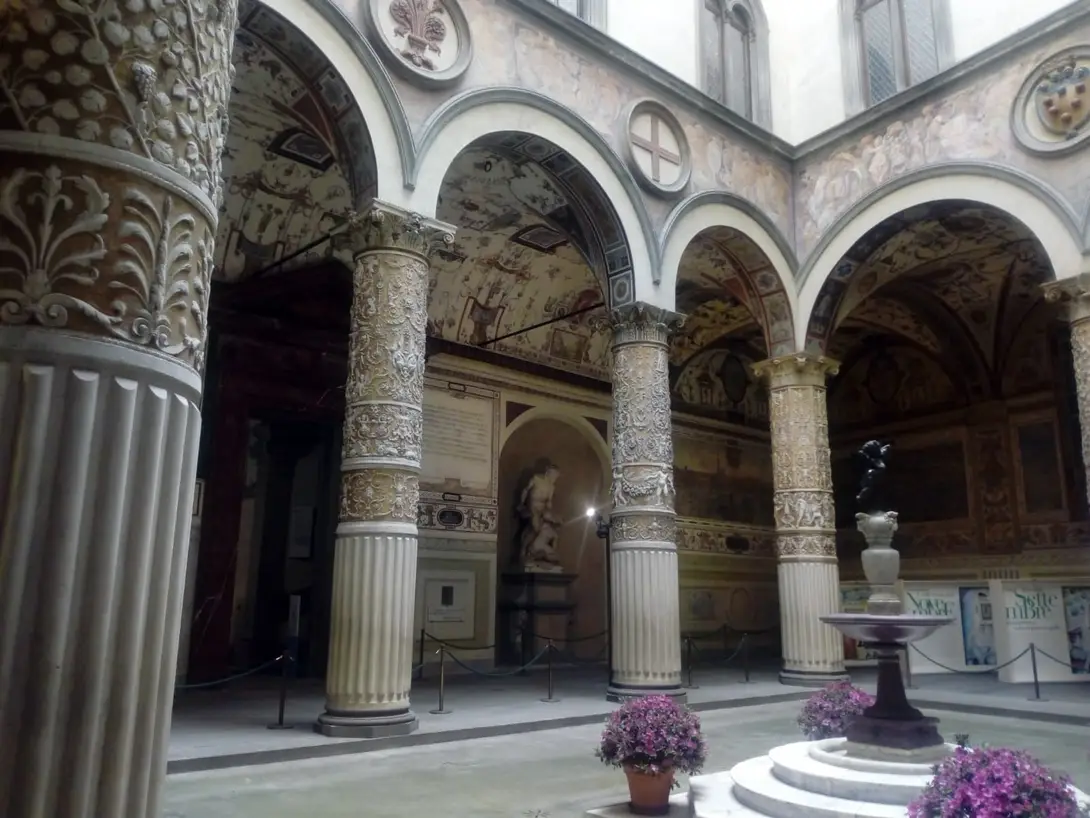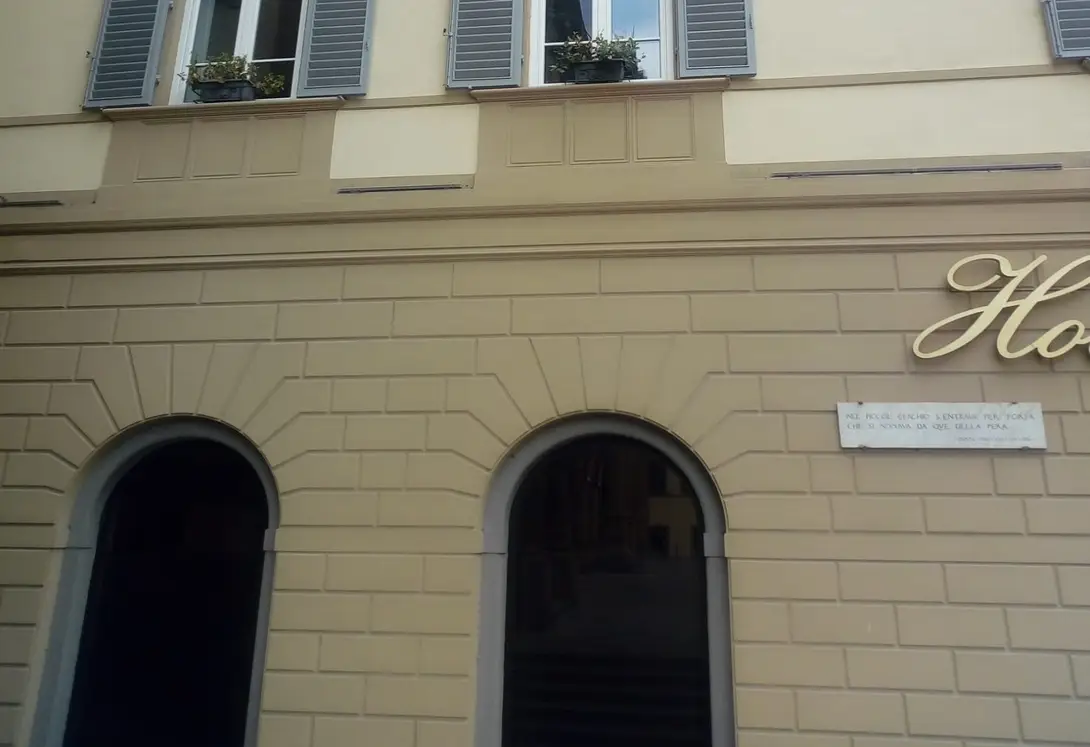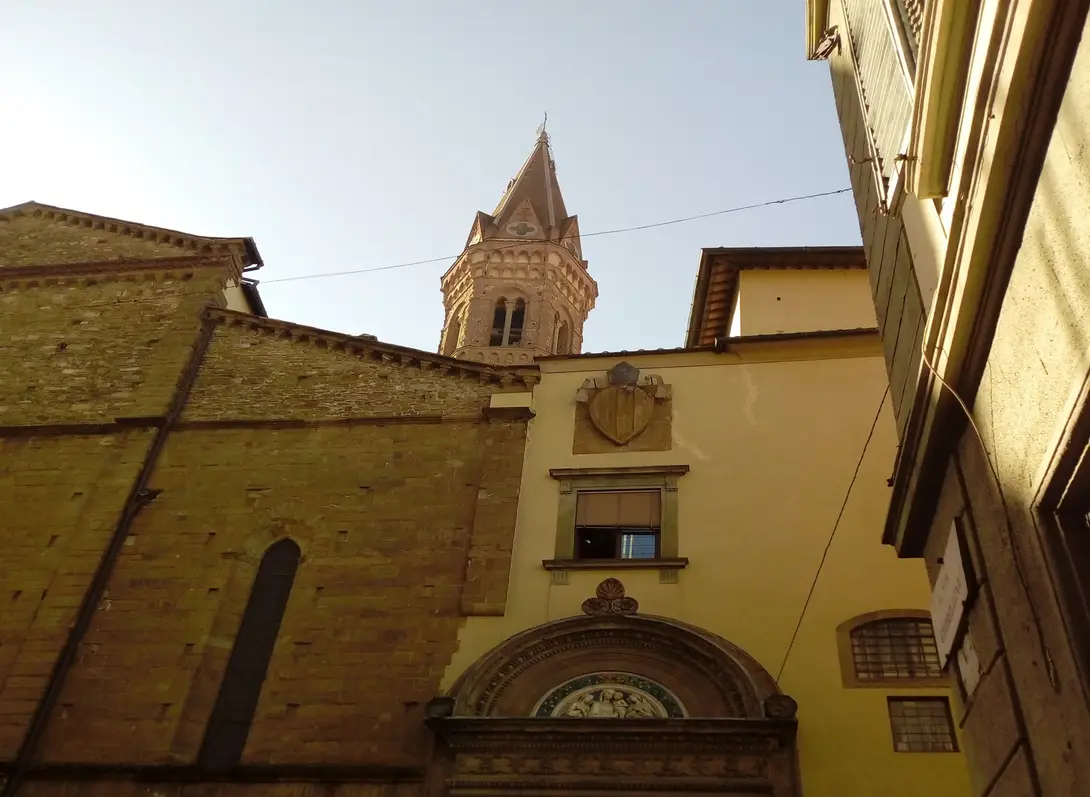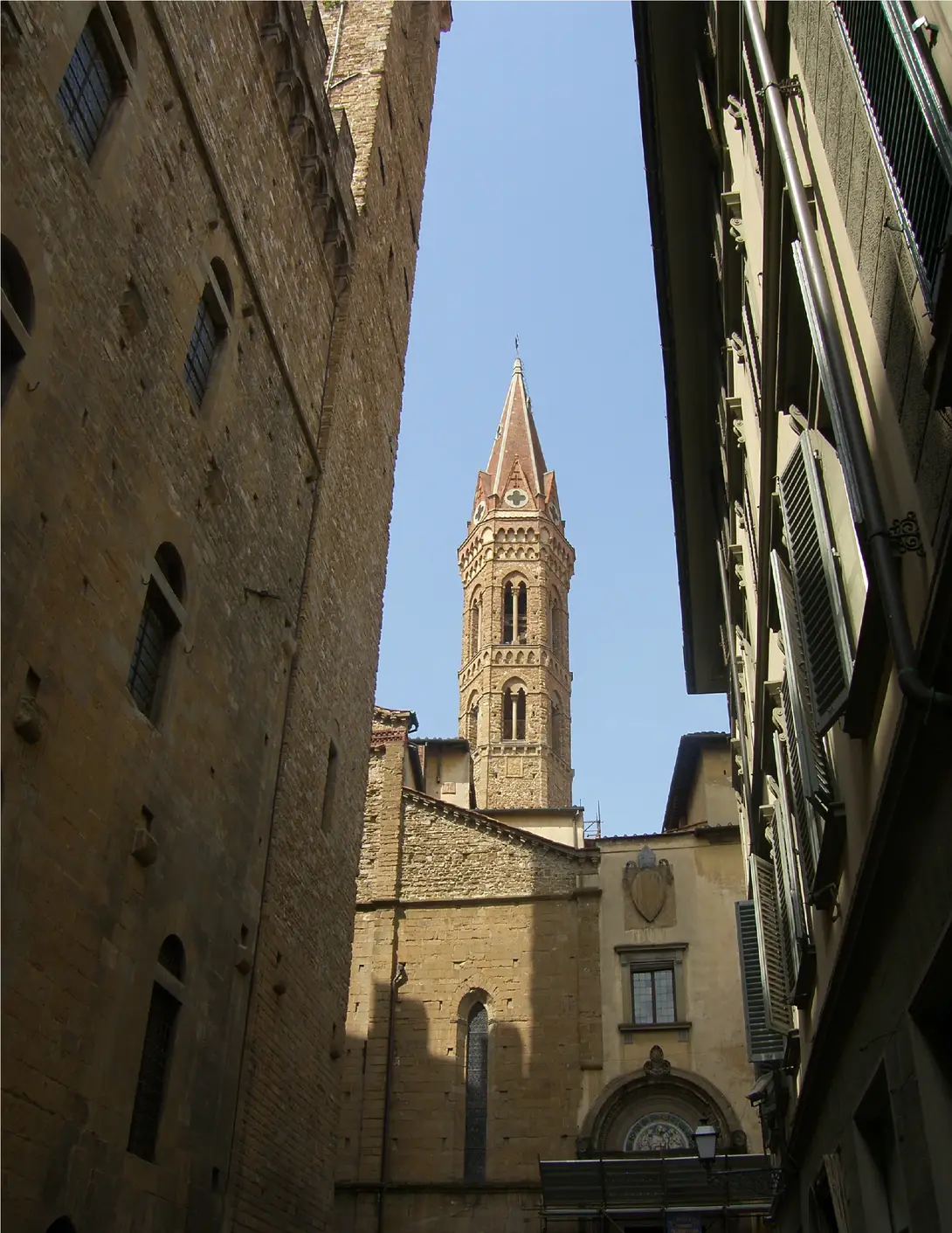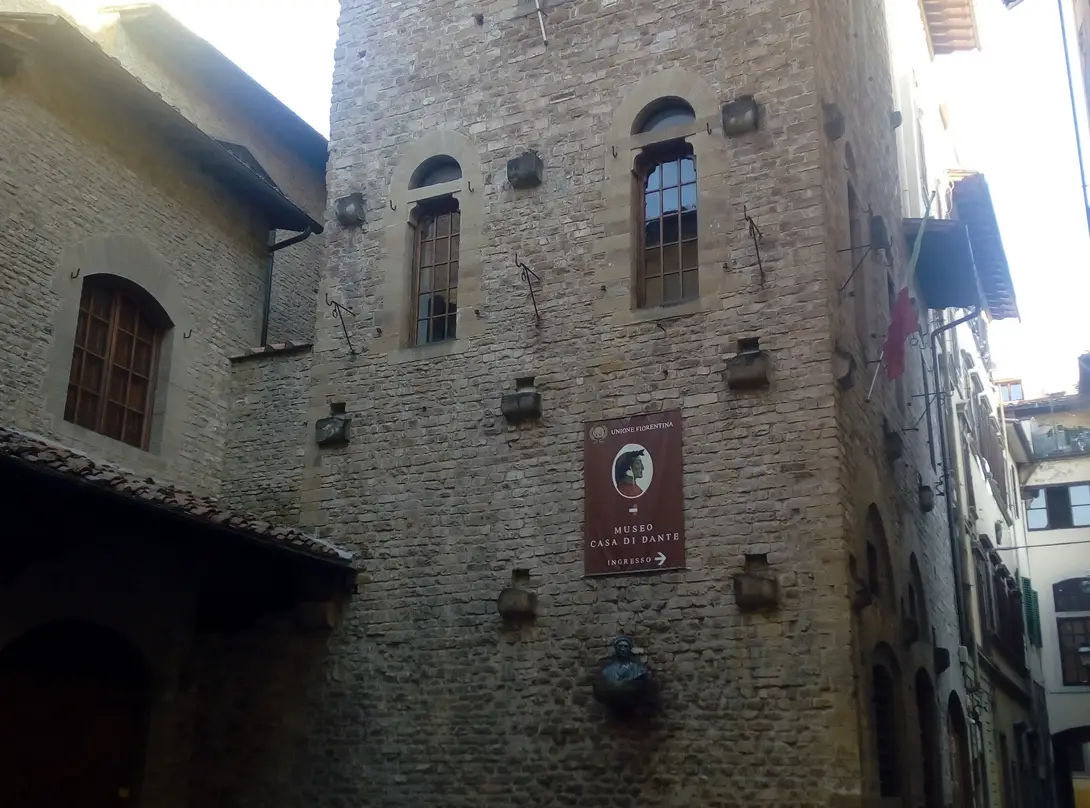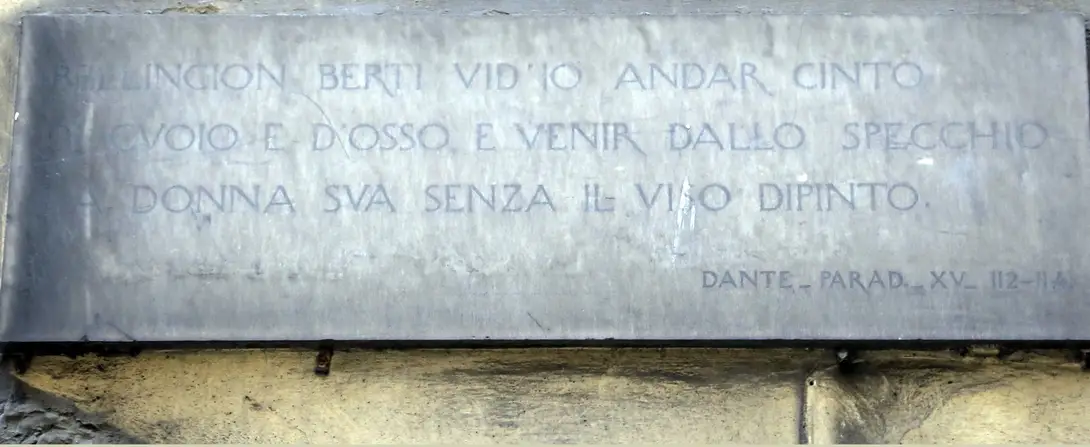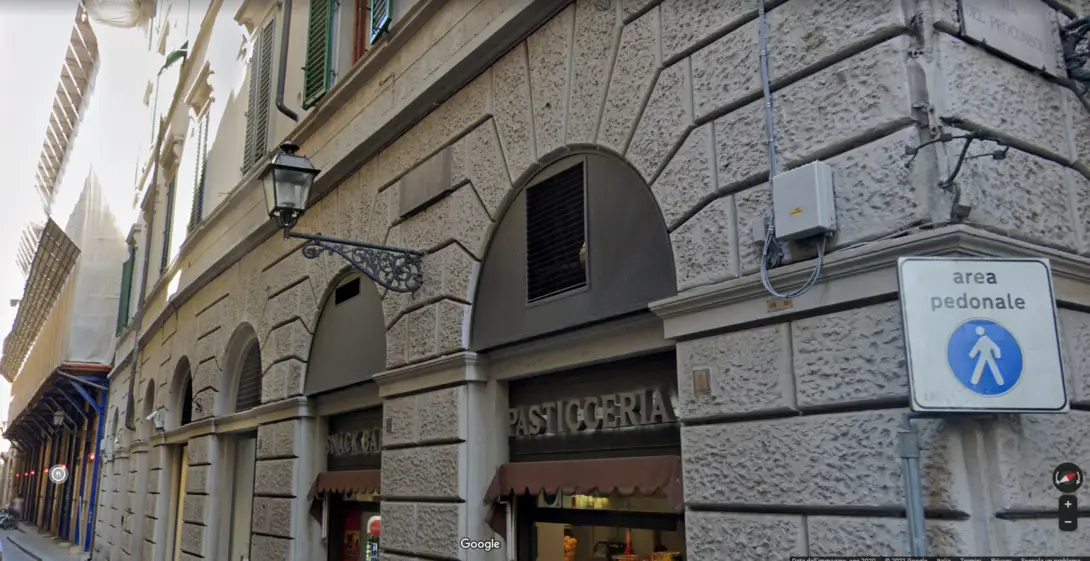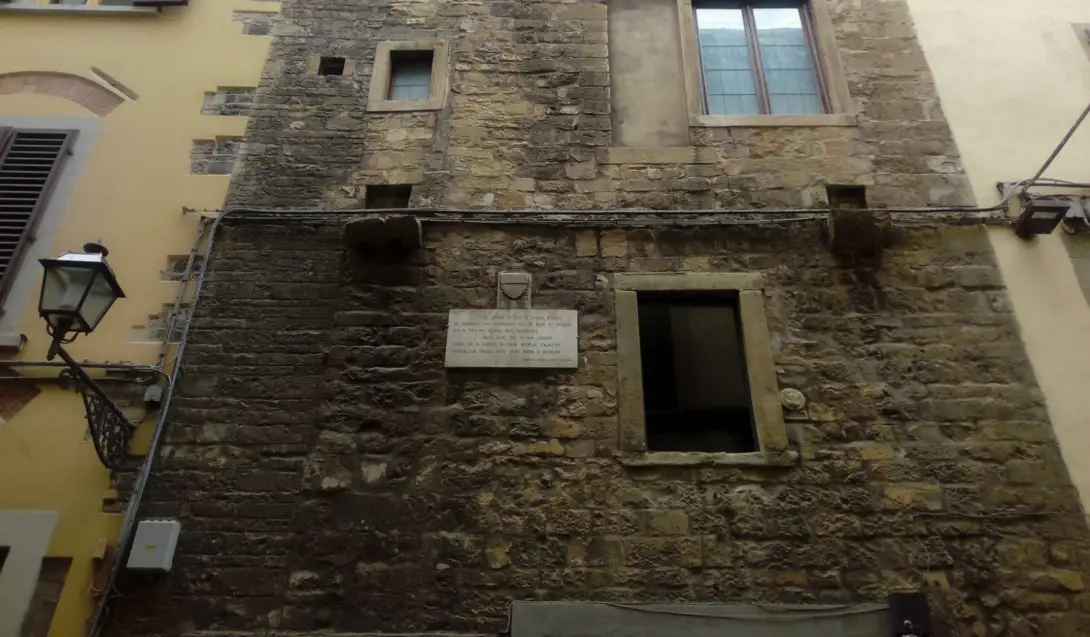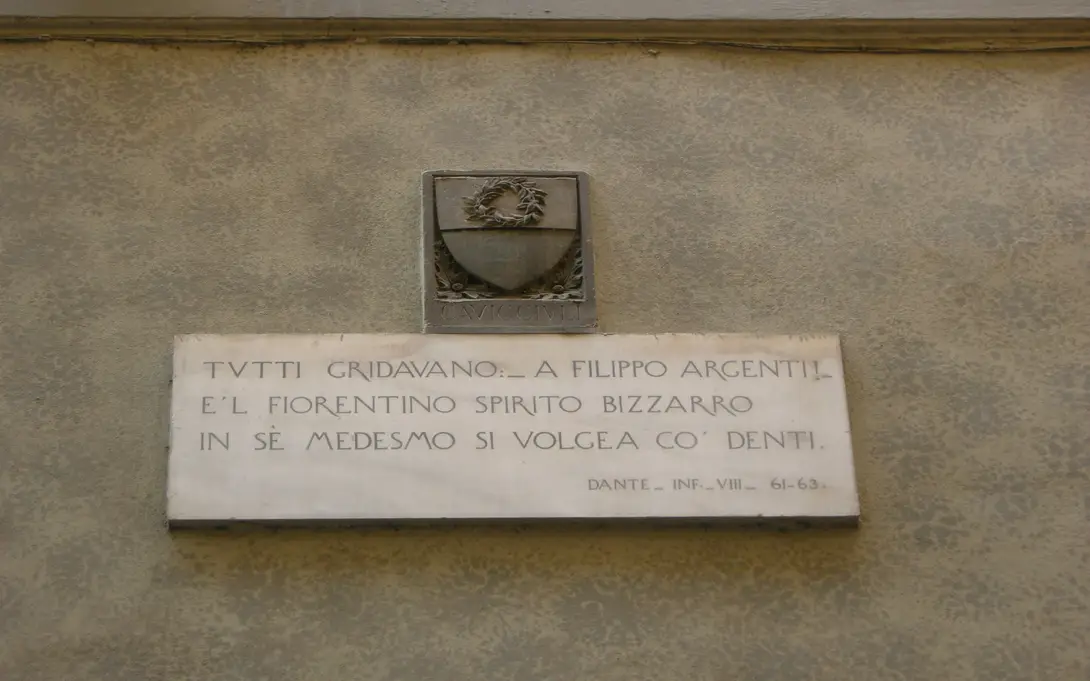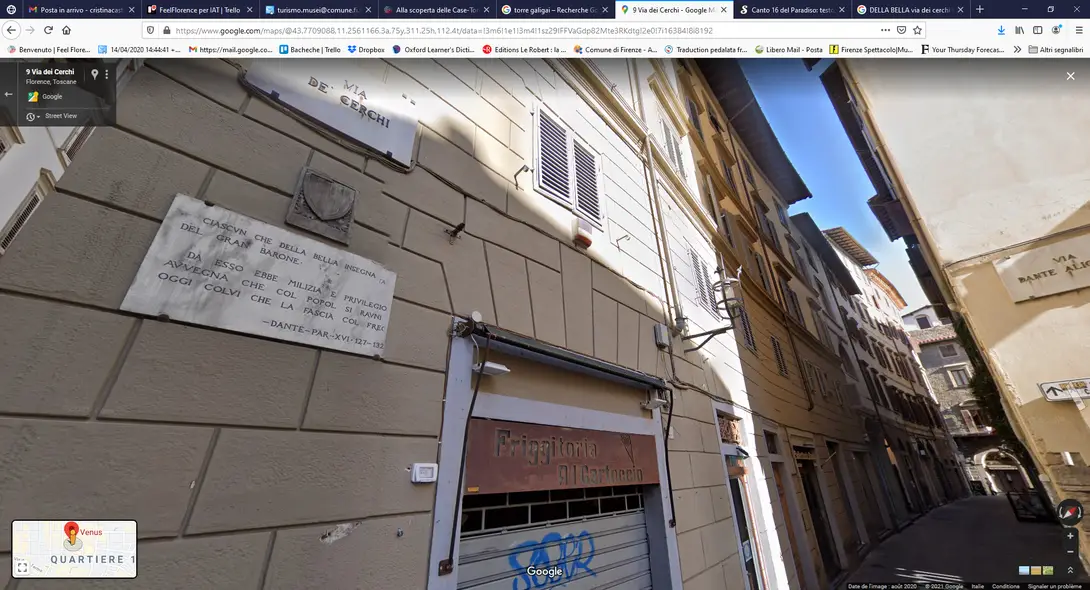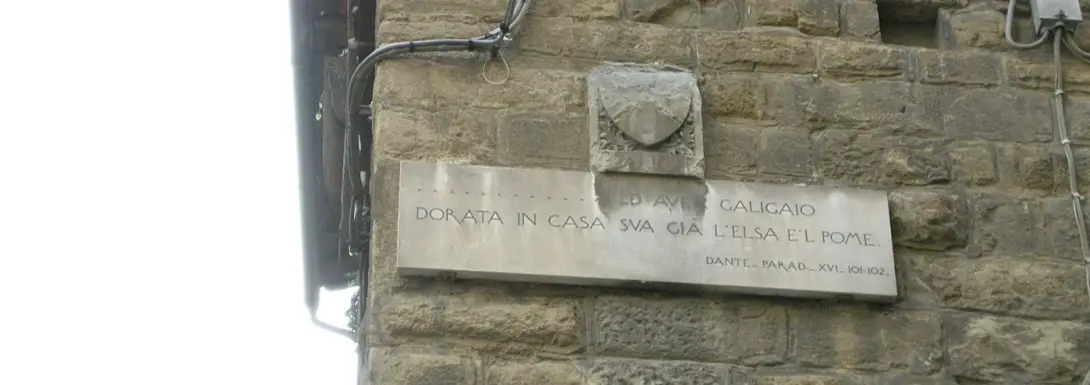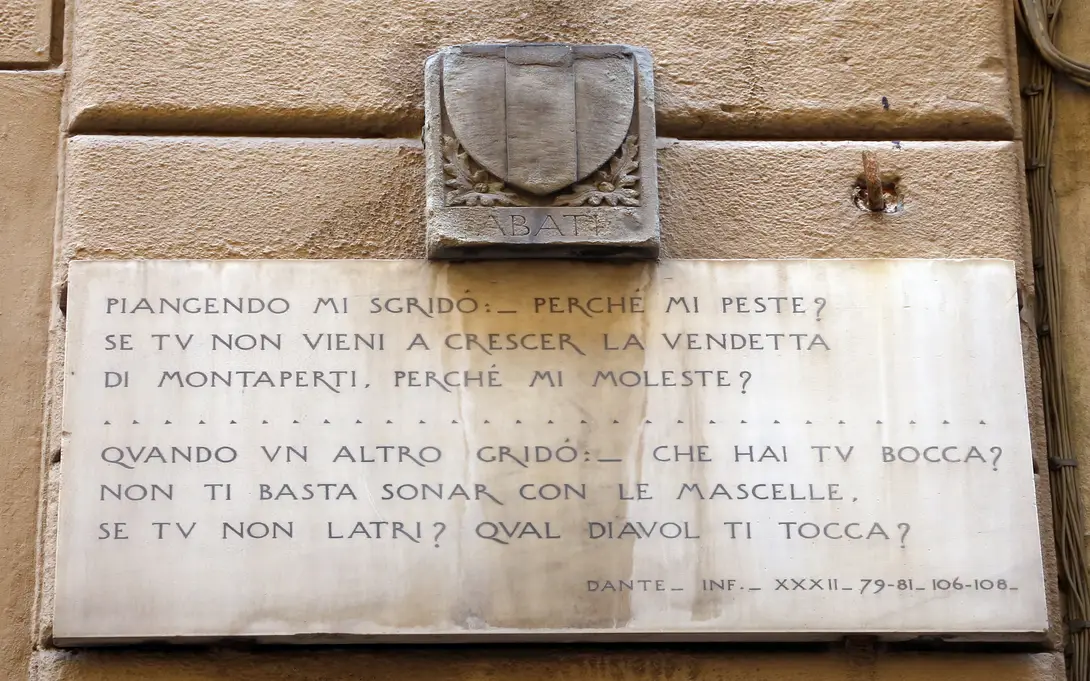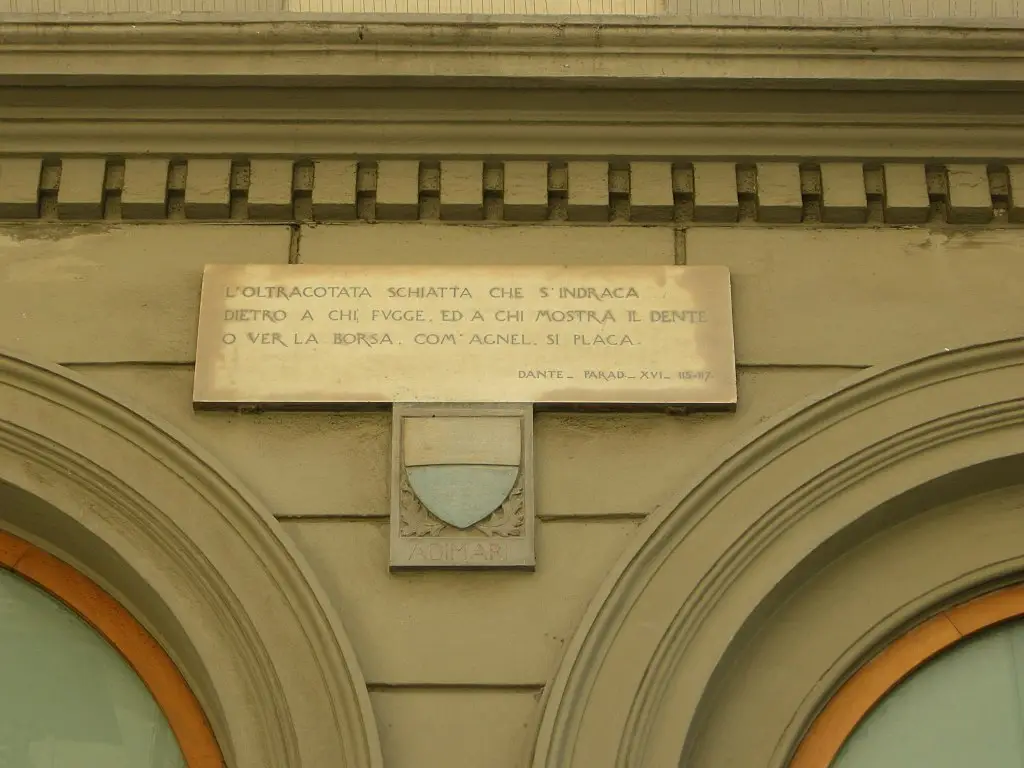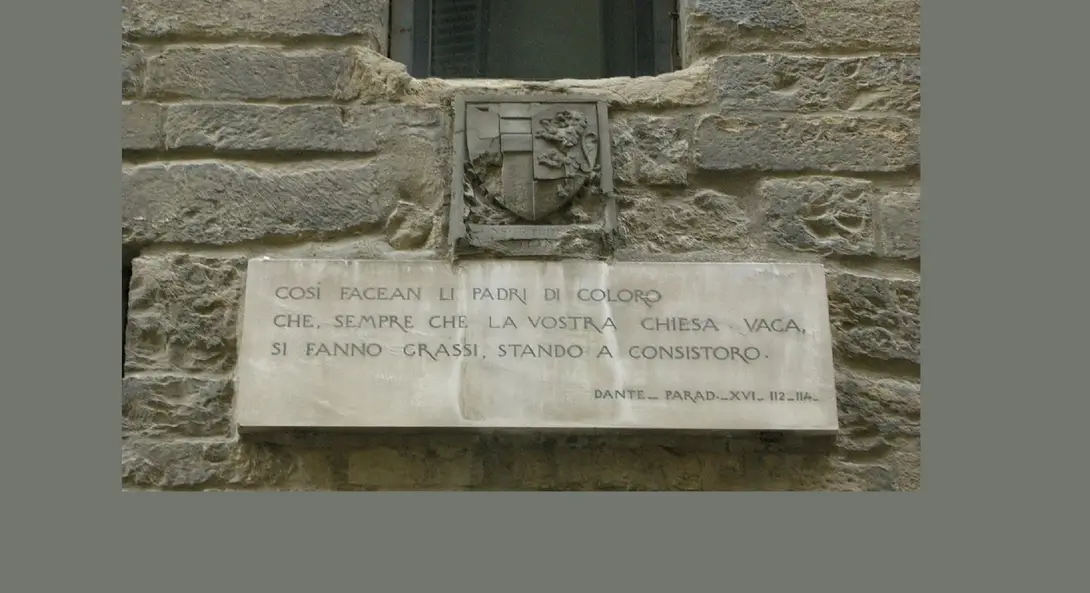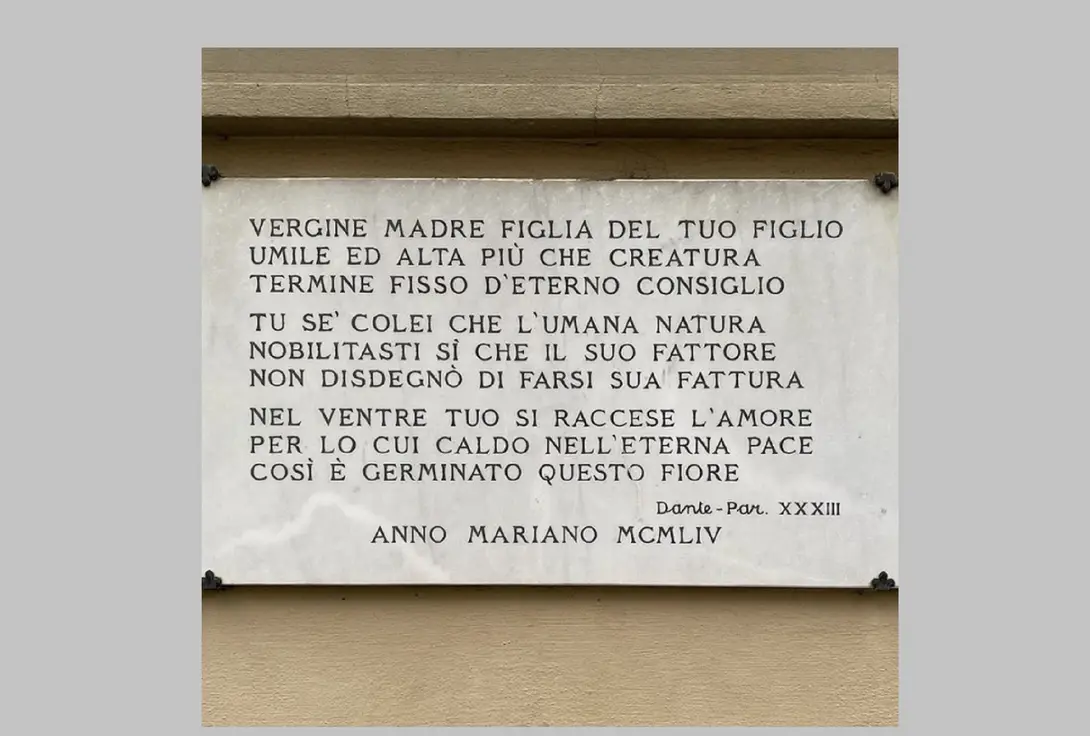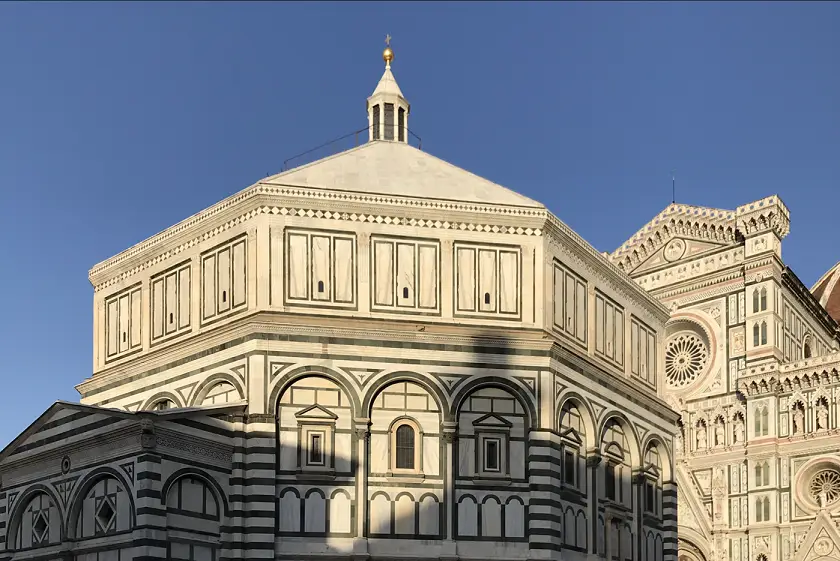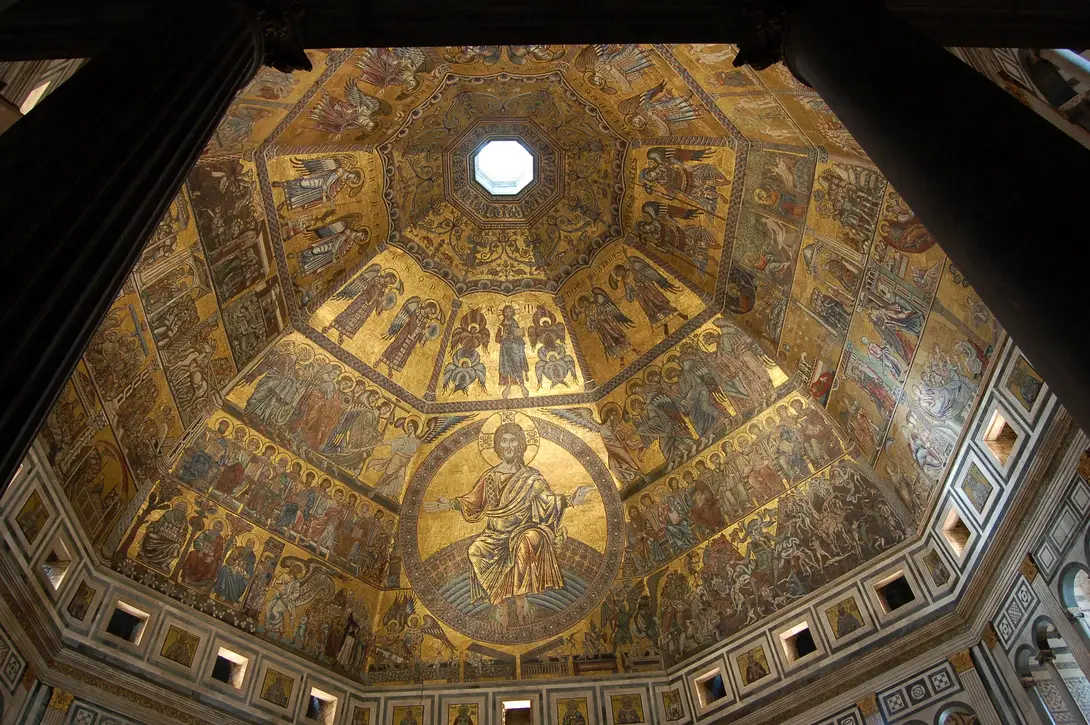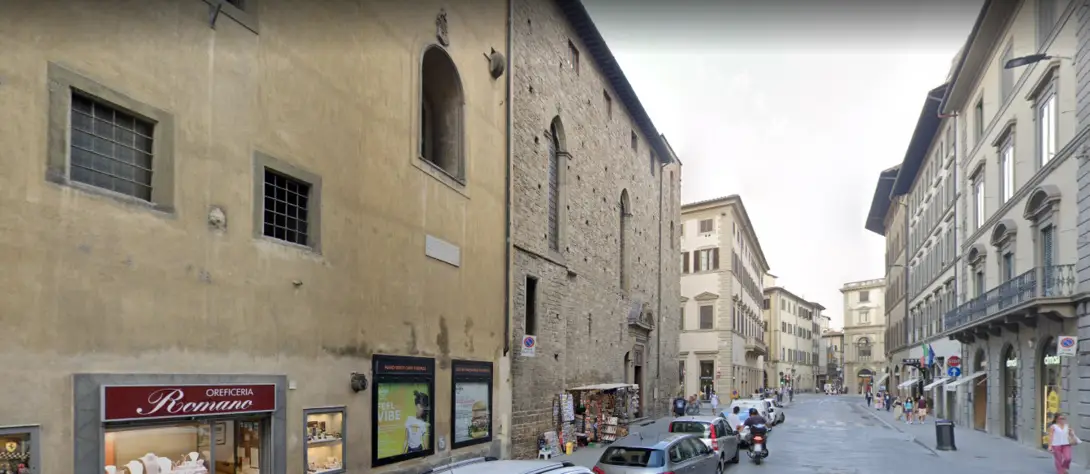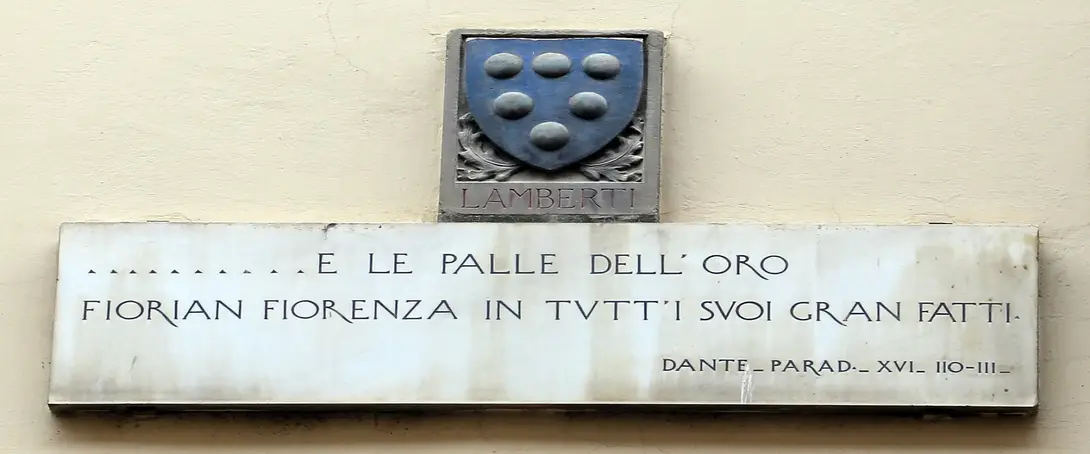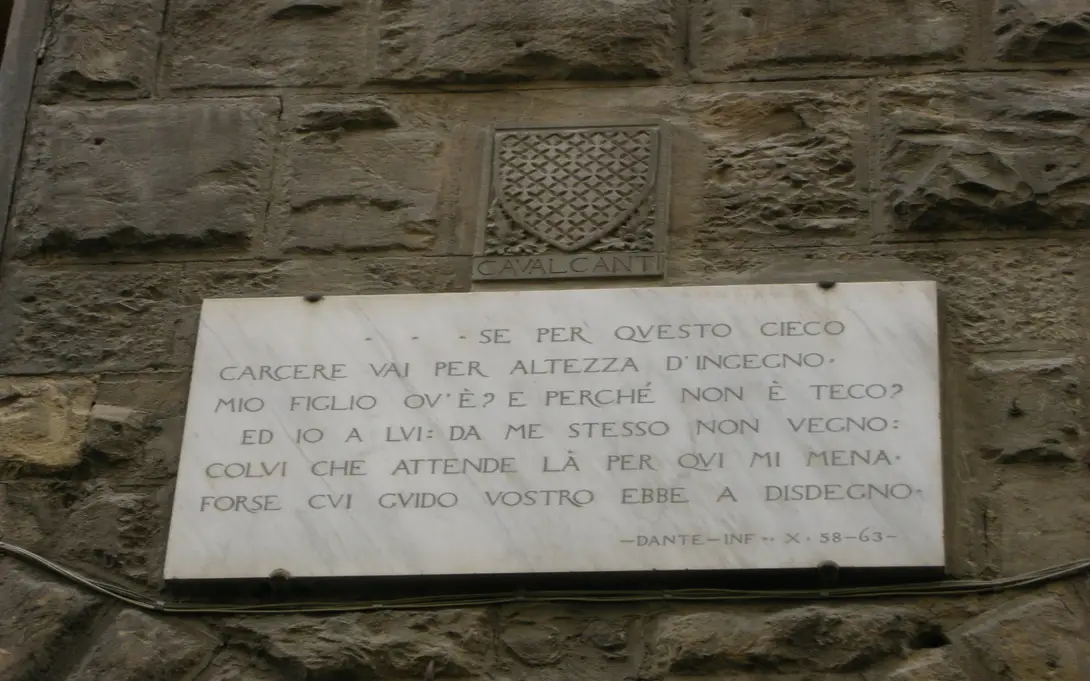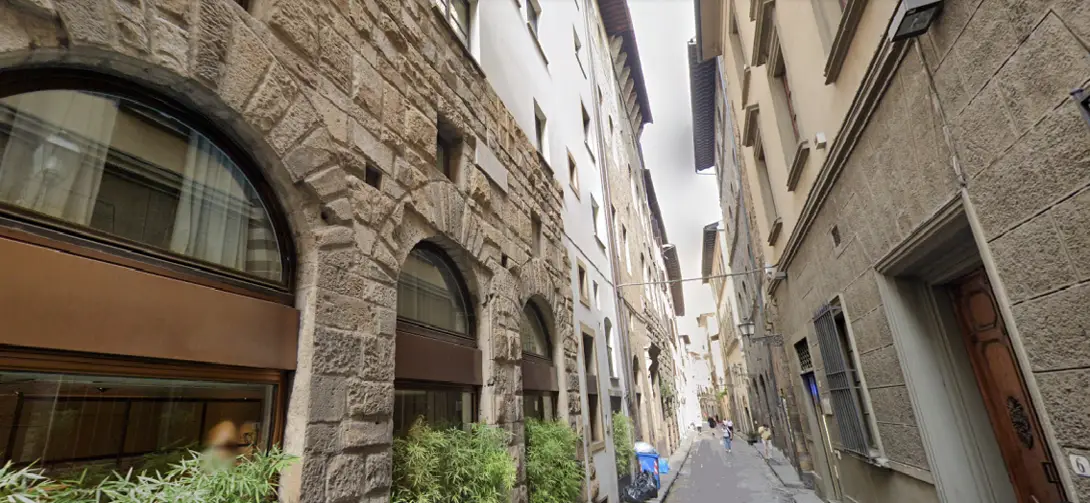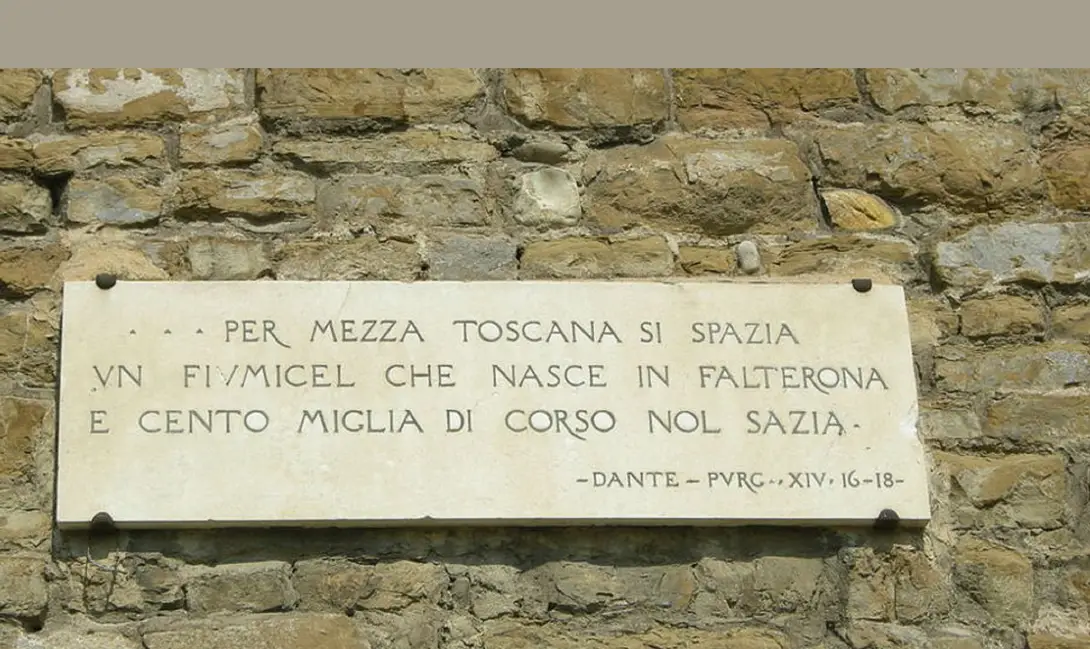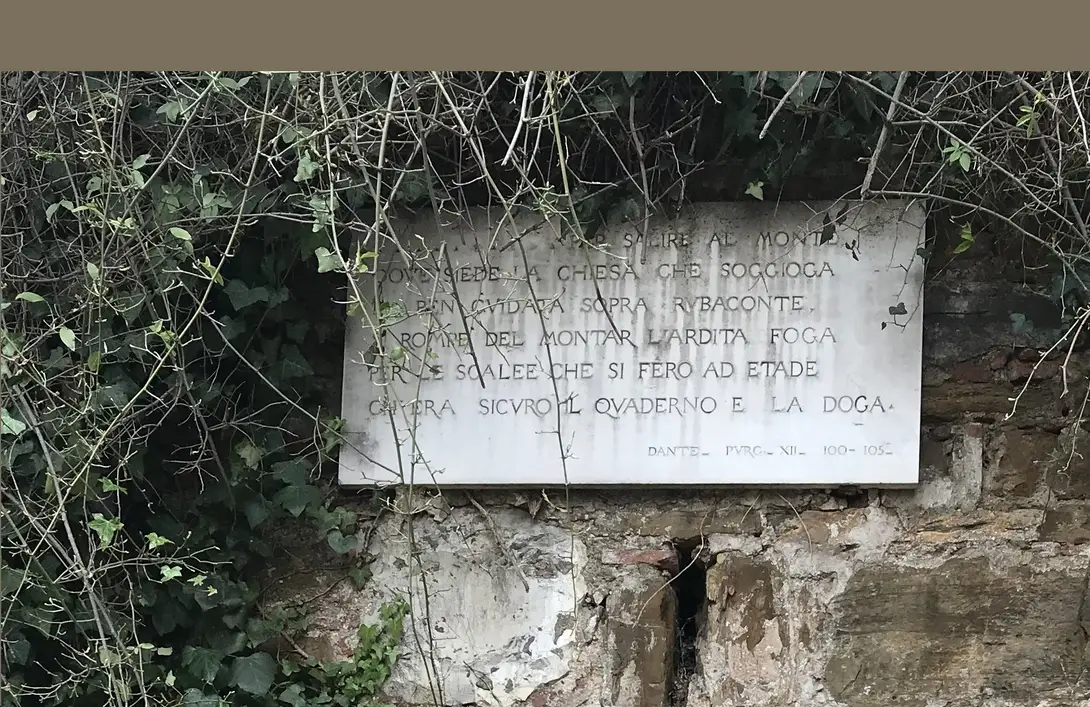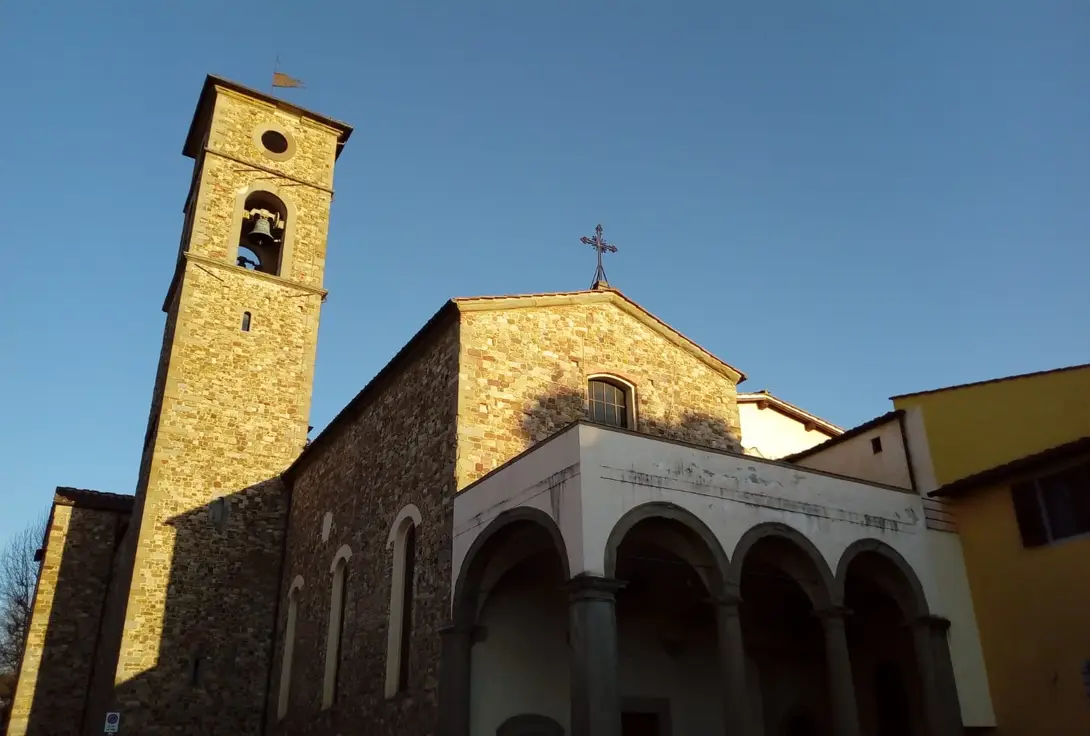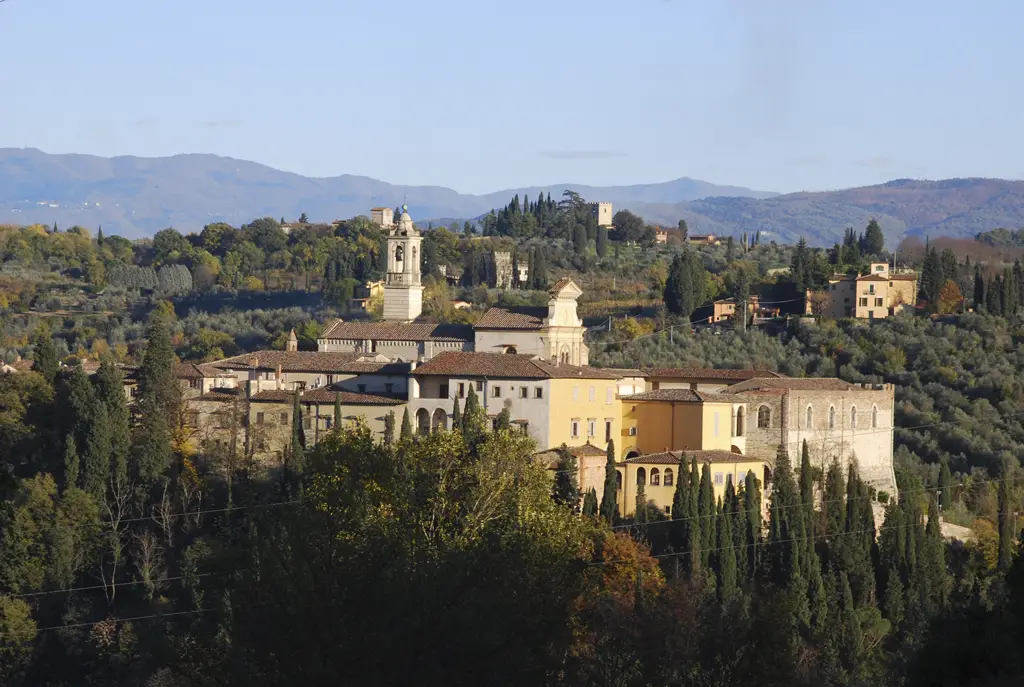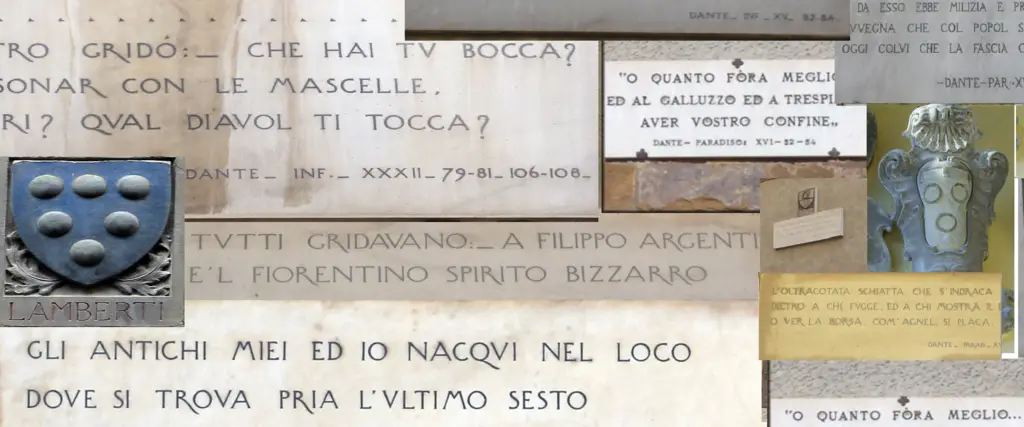
Dante's commemorative plaques in Florence
Strolling around Florence, it is easy to come across numerous commemorative plaques placed on the walls of palaces, churches and tower-houses. Many of these are Dante's plaques, real commemorative monuments that, for more than a century now, have adorned the historic center, transporting us back, as if by magic, to 14th-century Florence, celebrated in Dante's Divine Comedy.
The project of the plaques dates back to the beginning of the 20th century, when a commission of historians and Dante scholars undertook a long research to identify the exact places mentioned in the various cantos of Dante's Comedy. The plaques were placed as early as 1907, and in 1913, they were illustrated for the first time in Ida Riedisser's English publication 'Inscriptions from Dante's Divine Comedy in the Streets of Florence', designed for the city's foreign visitors.
Following this itinerary - thanks to these veritable “talking stones” - citizens and tourists will be able to retrace places and historical events where Dante was often a protagonist, and which also highlight the difficult relationship he had with his native city. In fact, each plaque contains a quotation from one of the three cantica: 9 from the Inferno, 5 from the Purgatorio and 19 from the Paradiso, for a total of 33 plaques, which refer to places in the city, real events and illustrious citizens of the time.
Below, we illustrate each stage of this itinerary. Besides the specific quotations, all the plaques are accompanied by brief comments and photos to help you discover places, people and events mentioned in the Divine Comedy.
For further information, see the itineraries Florence at the time of Dante and the Florentine tower-houses.
Comune di Firenze
Étapes
Dante's Plaque: Gianfigliazzi Palace
. . . COM'IO RIGUARDANDO TRA LOR VEGNO, IN UNA BORSA GIALLA VIDI AZZURRO, CHE D'UN LEONE AVEA FACCIA E CONTEGNO.
DANTE, INF., XVII, 58-60.
… AND AS I GAZING ROUND ME COME AMONG THEM, UPON A YELLOW POUCH I AZURE SAW THAT HAD THE FACE AND POSTURE OF A LION.
Dante and Virgil cross the circle of usurers, where the damned have been condemned to sit on a layer of burning sand and stare at the bags (a symbol of their job) they wear around their necks, which depict the coat of arms of the noble families they belong to. Dante recognizes the Gianfigliazzi, thanks to the blue lion on a yellow field painted on the bags. The Gianfigliazzi family owned opulent mansions in the area of Via Tornabuoni (where Dante’s memorial plaque is) and in the adjacent Lungarno Corsini.
Dante's Plaque: Ponte Vecchio
. . . CONVENIESI A QUELLA PIETRA SCEMA CHE GUARDA ‘L PONTE, CHE FIORENZA FESSE VITTIMA NELLA SUA PACE POSTREMA.
DANTE, PAR., XVI, 145-147.
BUT IT BEHOVED THE MUTILATED STONE WHICH GUARDS THE BRIDGE THAT FLORENCE SHOULD PROVIDE A VICTIM IN HER LATEST HOUR OF PEACE.
The main theme of this Canto is the decay of Florence and the end of peace for its inhabitants. These verses focus on the assassination of Buondelmonte Buondelmonti, which took place at the foot of the mutilated statue of Mars near Ponte Vecchio - side of Piazza del Pesce - where the plaque is located today. This episode marked the end of a peaceful civil life for Florence. Mars was the patron deity of Florence in pagan times.
To discover why some noble families decided to kill Buondelmonti, click here.
Dante's Plaque: Ponte Vecchio
. . . IN SUL PASSO D'ARNO.
DANTE, INF., XIII, 146.
…ON THE PASS OF ARNO
With this verse, Dante reminds us the Ponte Vecchio, the most famous bridge crossing over the Arno River. It is the only one in Florence that has remained intact (all the others have been destroyed by the Nazis during the Second World War); it was erected in the fourteenth century on the site of an older Roman bridge. The Plaque is placed in the loggia under the Corridoio Vasariano, halfway along the bridge.
For an itinerary to discover Florencebridges click here!
Dante's Plaque: Amidei Tower
LA CASA DI CHE NACQUE IL VOSTRO FLETO, PER LO GIUSTO DISDEGNO CHE V'HA MORTI E PUOSE FINE AL VOSTRO VIVER LIETO, ERA ONORATA, ESSA E SUOI CONSORTI.
DANTE, PAR., XVI, 136-139.
THE HOUSE FROM WHICH IS BORN YOUR LAMENTATION, THROUGH JUST DISDAIN THAT DEATH AMONG YOU BROUGHT AND PUT AN END UNTO YOUR JOYOUS LIFE, WAS HONOURED IN ITSELF AND ITS COMPANIONS.
Dante refers to the ancient and powerful Florentine Amidei family, whose tower, located, at the time, near Porta Santa Maria, from which the current street takes its name, was later lowered - like many others - as a result of Giano Della Bella's orders of justice. As the protagonists, together with the allied families, of Buondelmonte Buondelmonti’s murder, they took revenge for the broken promise of marriage. Hence the 'lamentation', to which the poet refers, caused by the 'just disdain', which gave rise to the fierce fighting between the Florentine factions of Guelphs and Ghibellines.
To learn more about the origin of the feud between Guelph and Ghibelline families, click here!
Dante's Plaque: Palazzo Vecchio Courtyard
“· · · FU’IO SOL COLÀ DOVE SOFFERTO FU PER CIASCUN DI TORRE VIA FIORENZA, COLUI CHE LA DIFESI A VISO APERTO."
DANTE, INF., X, 91-93.
"... BUT THERE I WAS ALONE, WHERE EVERY ONE CONSENTED TO THE LAYING WASTE OF FLORENCE, HE WHO DEFENDED HER WITH OPEN FACE."
With these verses, Dante honours the memory of Farinata degli Uberti that he sees in the circle of heretics. The noble Florentine leader of the Ghibelline party participated in the famous battle of Montaperti in 1260, when the Guelphs were defeated in Siena. Despite the harsh contrasts, the day after the victory, Farinata was the only one to oppose "with open face" the request to destroy Florence and saved it. Palazzo Vecchio was built in the area once occupied by many Ghibelline tower-houses (including those of the Uberti), destroyed by the Guelphs. This memorial plaque, along with two more, is placed inside the Michelozzo Courtyard.
Discover the Florentine tower-houseshere!
Dante's Plaque: Palazzo Vecchio Courtyard
“VID’IO FIORENZA IN SÍ FATTO RIPOSO CHE NON AVEA CAGION ONDE PIANGESSE. CON QUESTE GENTI VID’IO GLORIOSO E GIUSTO IL POPOL SUO, TANTO CHE ‘L GIGLIO NON ERA AD ASTA MAI POSTO A RITROSO, NÉ PER DIVISION FATTO VERMIGLIO”
DANTE, PAR., XVI, 149-154
“FLORENCE BEHELD I IN SO GREAT REPOSE, THAT NO OCCASION HAD SHE WHENCE TO WEEP; WITH ALL THESE FAMILIES BEHELD SO JUST AND GLORIOUS HER PEOPLE, THAT THE LILY NEVER UPON THE SPEAR WAS PLACED REVERSED, NOR BY DIVISION WAS VERMILION MADE."
Through the words of his ancestor Cacciaguida, Dante envisioned an idea of Florence in the past free from internal struggles, very different from the turbulent one he knew. At that time, it had never happened that the lily, the symbol of Florence, was put on backwards ("never upon the spear was placed reversed "), in sign of the defeat suffered by the rival faction. During the Ghibelline period of Florence, the lily was white on a red background, but with the advent of the Guelphs it was decided to change color: red lily (vermilion) on a white background. The plaque can be found in Palazzo Vecchio, which is, since its construction, the center of the political power of the city. The memorial plaque, along with two more, is placed in the Michelozzo Courtyard.
Dante's Plaque: Palazzo Vecchio Courtyard
OH QUALI IO VIDI QUEI CHE SON DISFATTI PER LOR SUPERBIA!
DANTE, PAR., XVI,109-110
O HOW BEHELD I THOSE WHO ARE UNDONE BY THEIR OWN PRIDE!
Among the noble families that Dante and Cacciaguida review, here we mention the Uberti, fallen into ruin because of their haughtiness and banished from the city due to their rebellion against the Municipal laws. The tower-houses of the Uberti stood in the area of Palazzo Vecchio, together with other noble Ghibelline families, demolished as they were exiled. It is on their ashes that the Guelph Civic Palace has been built - still under construction at the time of Dante. Next to this memorial plaque, there is another one about the famous Farinata degli Uberti (click here to learn more).
Dante's Plaque: Peruzzi's house
NEL PICCIOL CERCHIO S’ENTRAVA PER PORTA, CHE SI NOMAVA DA QUEI DELLA PERA
DANTE, PAR., XVI, 124 – 126
ONE ENTERED THE SMALL CIRCUIT BY A GATE WHICH FROM THE DELLA PERA TOOK ITS NAME!
The inscription refers to the ancient gates to the city (the first ring of walls dating 12° century) which took its name from the Peruzzi, a noble family whose emblem depicted, in fact, a pear (pera means pear>Peruzzi). The houses of this family were built in the area of the ancient Roman amphitheatre; two streets, via Torta and via Bentaccordi, have an unusual curved layout that retraces the semi-circle of the amphitheatre.
Dante's Plaque: Badia Fiorentina (Church)
CIASCUN CHE DELLA BELLA INSEGNA PORTA DEL GRAN BARONE, IL CUI NOME E ‘L CUI PREGIO LA FESTA DI TOMMASO RICONFORTA, DA ESSO EBBE MILIZIA E PRIVILEGIO
DANTE, PAR., XVI, 127-130
EACH ONE THAT BEARS THE BEAUTIFUL ESCUTCHEON OF THE GREAT BARON WHOSE RENOWN AND NAME THE FESTIVAL OF THOMAS KEEPETH FRESH, KNIGHTHOOD AND PRIVILEGE FROM HIM RECEIVED
Many noble Florentine families were awarded the order of chivalry by Ugo Marchese of Tuscany (the "Great Baron" who moved the seat of the marquisate from Lucca to Florence and died in 1001). Since time immemorial, every year on the same day, December 21 - dedicated to Saint Thomas the Apostle-, religious services are dedicated to Marquis Ugo at the Badia Fiorentina, where the Great Baron was buried.
Dante's Plaque: Badia Fiorentina (Church)
FIORENZA, DENTRO DALLA CERCHIA ANTICA, OND' ELLA TOGLIE ANCORA E TERZA E NONA, SI STAVA IN PACE SOBRIA E PUDICA
DANTE, PAR., XV, 97-99
FLORENCE, WITHIN THE ANCIENT BOUNDARY FROM WHICH SHE TAKETH STILL HER TIERCE AND NONES, ABODE IN QUIET, TEMPERATE AND CHASTE.
Cacciaguida, Dante’s great-grandfather, died in the Holy Land during the crusades, reminds us the time of the "ancient city wall" (when the medieval city was enclosed within the perimeter of the Carolingian walls). At that time, Florentines’ life was chaste and serene, punctuated by the sound of the bells of the Badia Fiorentina, one of the oldest church in the city where this stone plaque is placed (entrance of the church from Via Dante Alighieri).
Dante's Plaque: Dante's House
...I' FUI NATO E CRESCIUTO SOVRA 'L BEL FIUME D'ARNO ALLA GRAN VILLA
DANTE, INF., XXIII, 94-95
…BORN WAS I, AND GREW UP IN THE GREAT TOWN ON THE FAIR RIVER OF ARNO
These are Dante’s words in response to the question asked by two friars, in the circle of hypocrites. In the poet’s answer and in the adjectives he chose, we guess his homesickness for Florence: the river, the Arno, is beautiful; the city, Florence, is large, where the term "large" refers not only to the city’s geographical extent, but also to its reputation.
This Dante’s plaque is located at 2, Via Dante Alighieri, near the Museo Casa di Dante, a reconstruction of the Alighieri’s House dating back the early 1900s.
Dante's Plaque: Ravignani's Houses
BELLINCION BERTI VID'IO ANDAR CINTO DI CUOIO E D`OSSO, E VENIR DALLO SPECCHIO LA DONNA SUA SANZA IL VISO DIPINTO
DANTE, PAR., XV, 112 – 114
BELLINCION BERTI SAW I GO BEGIRT WITH LEATHER AND WITH BONE, AND FROM THE MIRROR HIS DAME DEPART WITHOUT A PAINTED FACE
Bellincione Berti de' Ravignani is described by Dante, through the words of his ancestor Cacciaguida, as an example of sobriety and simplicity in the ancient Florence. We saw Bellincione wearing a simple leather belt and bone buckle, and his wife without makeup. The Ravignani were one of the most esteemed noble families of the 12° century, who settled in this area of the city.
Dante's Plaque: Portinari’s houses
SOVRA CANDIDO VEL, CINTA D' OLIVA, DONNA M' APPARVE SOTTO VERDE MANTO VESTITA DI COLOR DI FIAMMA VIVA
DANTE, PUR., XXX , 31-33
OVER HER SNOW-WHITE VEIL WITH OLIVE CINCT APPEARED A LADY UNDER A GREEN MANTLE, VESTED IN COLOUR OF THE LIVING FLAME.
Almost at the end of his journey in the Purgatorio, Dante has a vision of a woman who will later prove to be his muse, Beatrice. She is dressed in white, green and red (the colors of the theological virtues: Faith, Hope and Charity) and crowned with an olive branch - the symbol of peace and wisdom.
The plaque can be seen on the façade of Palazzo Portinari-Salviati; in this area, Folco Portinari, Beatrice's father - the founder of Santa Maria Nuova Hospital - had some houses which were transformed into a real palace during the 15th century.
Dante's Plaque: Cerchi's Houses
…LA PORTA, CH'AL PRESENTE È CARCA DI NUOVA FELLONIA, DI TANTO PESO, CHE TOSTO FIA IATTURA DELLA BARCA
DANTE, PARAD., XVI, 94 – 96
…THE GATE THAT IS AT PRESENT LADEN WITH A NEW FELONY OF SO MUCH WEIGHT THAT SOON IT SHALL BE JETSAM FROM THE BARK
Cacciaguida, Dante’s ancestor, describes Florence of his time: it refers in particular to the areaof Porta San Piero, where new inhabitants, coming from the countryside, settled. According to Dante, they somehow corrupted the ancient value system.
The Cerchi family, one of the richest families at that time, bought some houses in the ancient Florence bordering those of the Donati. The conflict between these two families is one of the causes of internal rivalries between white Guelphs and black Guelphs.
Dante's Plaque: Donati Tower
“…’L LOCO, U' FUI A VIVER POSTO, DI GIORNO IN GIORNO PIU' DI BEN SI SPOLPA, ED A TRISTA RUINA PAR DISPOSTO”. “OR VA” DISS’EL “CHE QUEI PIU' N' HA COLPA VEGG' IO A CODA D'UNA BESTIA TRATTO INVER LA VALLE OVE MAI NON SI SCOLPA”
DANTE, PURG., XXIV, 79-84
… THE PLACE WHERE I WAS SET TO LIVE FROM DAY TO DAY OF GOOD IS MORE DEPLETED, AND UNTO DISMAL RUIN SEEMS ORDAINED". "NOW GO," HE SAID, "FOR HIM MOST GUILTY OF IT AT A BEAST'S TAIL BEHOLD I DRAGGED ALONG TOWARDS THE VALLEY WHERE IS NO REPENTANCE.
The plaque is placed on the Tower of the Donati, one of the most powerful and ancient families in the city. We are in the third circle, the gluttons' one, and Dante is in the company of Forese Donati. Initially the Poet talks about his homeland, deploring its moral decay, and then Forese has a premonition of the tragic end of his brother Corso (discover it through Dante's Plaque in San Salvi).
Find out more about the tower houses on this itinerary.
Dante's Plaque: Adimari's Houses
TUTTI GRIDAVANO: “A FILIPPO ARGENTI!” E’L FIORENTINO SPIRITO BIZZARRO IN SÈ MEDESMO SI VOLGEA CO' DENTI.
DANTE, INF., VIII, 61-63.
THEY ALL WERE SHOUTING, "AT PHILIPPO ARGENTI!" AND THAT EXASPERATE SPIRIT FLORENTINE TURNED ROUND UPON HIMSELF WITH HIS OWN TEETH.
Dante meets Filippo Argenti in the Stygian swamp, where angry people are punished. Related to the Adimari, Filippo was a very rich knight, a violent and arrogant man. According to a legend, he was given the nickname Argenti because he used to shoe his horse with silver (in Italian argento). When Dante sees him, the damned are shouting "at Filippo Argenti" and the spirit reacts by biting himself. The poet thanks God for this punishment, because there was bad blood between the family of Alighieri and the one of Filippo Argenti.
Dante's Plaque: Della Bella's Houses
CIASCUN CHE DELLA BELLA INSEGNA PORTA DEL GRAN BARONE … DA ESSO EBBE MILIZIA E PRIVILEGIO; AVVEGNA CHE CON POPOL SI RAUNI OGGI COLUI CHE LA FASCIA COL FREGIO.
DANTE, PAR., XVI, 127-132.
EACH ONE THAT BEARS THE BEAUTIFUL ESCUTCHEON OF THE GREAT BARON…. KNIGHTHOOD AND PRIVILEGE FROM HIM RECEIVED; THOUGH WITH THE POPULACE UNITES HIMSELF TO-DAY THE MAN WHO BINDS IT WITH A BORDER.
Among the noble Florentine families who were awarded the order of chivalry by Ugo Marchese di Toscana (the "Great Baron"- buried in the Badia Fiorentina - who moved the seat of the marquisate from Lucca to Florence) was that one of the Della Bella, whose coat of arms was adorned with a golden band. Here, in particular, reference is to Giano Della Bella, who sided with the people, signing his famous "Ordinances of Justice" of 1293.
Dante's Plaque: Galigai Tower
. . . ED AVEA GALIGAIO DORATA IN CASA SUA GIÀ L'ELSA E'L POME.
DANTE, PAR., XVI, 101-102.
…AND ALREADY GALIGAJO HAD HILT AND POMMEL GILDED IN HIS HOUSE.
Among the noble members that Dante and Cacciaguida mention in this canto, there is the Galigai family, who had the privilege, granted to noble knights by Charlemagne, of having the pommel and the hilt of the sword guilded. The towers of the ancient Galigai family were located in Via dei Cerchi, in one of the oldest areas of the historic center of Florence, where now there is one single building. The plaque has been affixed onto the tower, at the intersection of Via dei Cerchi and Piazza dei Cimatori.
To find out more about tower houses in Florence, click here.
Dante's Plaque: Abati's Houses
PIANGENDO MI SGRIDÒ: “PERCHÉ MI PESTE? SE TU NON VIENI A CRESCER LA VENDETTA DI MONTAPERTI, PERCHÉ MI MOLESTE? ...UN ALTRO GRIDÒ: “CHE HAI TU, BOCCA? NON TI BASTA SONAR CON LE MASCELLE, SE TU NON LATRI? QUAL DIAVOL TI TOCCA?”
DANTE, INF., XXXII, 79-81 & 106-108.
WEEPING HE GROWLED: "WHY DOST THOU TRAMPLE ME? UNLESS THOU COMEST TO INCREASE THE VENGEANCE OF MONTAPERTI, WHY DOST THOU MOLEST ME?" WHEN CRIED ANOTHER, "WHAT DOTH AIL THEE, BOCCA? IS 'T NOT ENOUGH TO CLATTER WITH THY JAWS, BUT THOU MUST BARK? WHAT DEVIL TOUCHES THEE?"
We are in the ninth circle of hell where those who committed treason against their country have their bodies and heads above the ice. One of these heads, which Dante accidentally kicks while walking, belongs to Bocca degli Abati who, according to some sources, betrayed the Florentine army leading it to defeat in the Battle of Montaperti in 1260 (when the Ghibelline troops headed by Siena won the battle). Another sinner turns to Bocca, and asks him, “Is it not enough hearing your teeth chattering for the cold and you barking like a dog? What the hell is wrong with you?”
Dante's Plaque: Adimari Cavicciuoli's Houses
L'OLTRACOTATA SCHIATTA CHE S' INDRACA DIETRO A CHI FUGGE, E A CHI MOSTRA ‘L DENTE O VER LA BORSA, COM' AGNEL SI PLACA
DANTE, PARAD., XVI, 115-117
THE INSOLENT RACE, THAT LIKE A DRAGON FOLLOWS, WHOEVER FLEES, AND UNTO HIM THAT SHOWS HIS TEETH OR PURSE IS GENTLE AS A LAMB
Dante’s indignation, expressed through the words spoken by the ancestor Cacciaguida, is perfectly understandable: Boccaccio Adimari took possession of the Poet’s assets as he was exiled. Paraphrase: the arrogant family becomes a dragon (“s'indraca” Dante’s neologism) in front of those who are forced to flee, but it is meek like a lamb towards the most powerful and rich men.
Dante's Plaque: Visdomini's House and Tower
“COSÌ FACIENO LI PADRI DI COLORO, CHE, SEMPRE CHE LA VOSTRA CHIESA VACA, SI FANNO GRASSI STANDO A CONSISTORO”
DANTE, PARAD., XVI, 112-114
SO LIKEWISE DID THE ANCESTORS OF THOSE WHO EVERMORE, WHEN VACANT IS YOUR CHURCH, FATTEN BY STAYING IN CONSISTORY.
Dante's verses refer to the Visdomini family. Along with other families, they were in charge of the vacant episcopal see (while waiting for a new bishop to be appointed), which enriched them and took considerable benefits.
The building still retains its ancient features, with the façade decorated with granite panels, interbedded with sections of phytomorphic elements. The terrace was added later. Next to the building stands the tall medieval tower on which the plaque is affixed.
To learn more about the tower-houses of Florence click here
Dante's Plaque: Piazza del Duomo
“VERGINE MADRE, FIGLIA DEL TUO FIGLIO, UMILE ED ALTA PIÙ CHE CREATURA, TERMINE FISSO D'ETERNO CONSIGLIO, TU SE' COLEI CHE L'UMANA NATURA NOBILITASTI SÌ, CHE ‘L SUO FATTORE NON DISDEGNÒ DI FARSI SUA FATTURA. NEL VENTRE TUO SI RACCESE L'AMORE PER LO CUI CALDO NELL' ETERNA PACE COSÌ È GERMINATO QUESTO FIORE”
DANTE, PAR., XXXIII, 1-9
"THOU VIRGIN MOTHER, DAUGHTER OF THY SON, HUMBLE AND HIGH BEYOND ALL OTHER CREATURE, THE LIMIT FIXED OF THE ETERNAL COUNSEL, THOU ART THE ONE WHO SUCH NOBILITY TO HUMAN NATURE GAVE, THAT ITS CREATOR DID NOT DISDAIN TO MAKE HIMSELF ITS CREATURE. WITHIN THY WOMB REKINDLED WAS THE LOVE, BY HEAT OF WHICH IN THE ETERNAL PEACE AFTER SUCH WISE THIS FLOWER HAS GERMINATED.”
Dante is now ready for the final stage of his journey to the Underworld, and it is here, in Paradise, that St Bernard addresses a prayer to the Virgin Mary; a sublime prayer that she intercedes to enable the poet to be admitted at the presence of God. The saint sings the praises of Mary, mother of the Redeemer and source of hope and charity for all men who can reach God through her. It is no coincidence that the plaque is located at the headquarters of the Arciconfraternita della Misericordia, symbol of the Florentines' Christian charity.
For further information on hospitality and charity tradition in Florence, click here.
Dante's Plaque: Battistero di San Giovanni
SE MAI CONTINGA CHE 'L POEMA SACRO AL QUALE HA POSTO MANO E CIELO E TERRA SÌ CHE M' HA FATTO PER PIU' ANNI MACRO, VINCA LA CRUDELTÀ CHE FUOR MI SERRA DEL BELLO OVILE, OV' IO DORMI' AGNELLO NIMICO AI LUPI, CHE LI DANNO GUERRA; CON ALTRA VOCE OMAI, CON ALTRO VELLO RITORNERÒ POETA, ED IN SUL FONTE DEL MIO BATTESMO PRENDERÒ 'L CAPPELLO.
DANTE, PAR, XXV, 1-9.
IF E'ER IT HAPPEN THAT THE POEM SACRED, TO WHICH BOTH HEAVEN AND EARTH HAVE SET THEIR HAND, SO THAT IT MANY A YEAR HATH MADE ME LEAN, O'ERCOME THE CRUELTY THAT BARS ME OUT, FROM THE FAIR SHEEPFOLD, WHERE A LAMB I SLUMBERED, AN ENEMY TO THE WOLVES THAT WAR UPON IT, WITH OTHER VOICE FORTHWITH, WITH OTHER FLEECE, POET WILL I RETURN, AND AT MY BAPTISMAL FONT I WILL I TAKE THE LAUREL CROWN.
In this “canto” of the Paradise, Dante expresses with emotion the hope that he will return to Florence, and, aware to be a great poet, he imagines himself receiving "the hat" (the laurel wreath) just where he was baptized. Unfortunately, he will never return from the exile. Dante’s plaque is located at the foot of the Baptistery, side via Calzaiuoli.
To discover the affectionate nickname that Dante gave the Baptistery in the Divine Comedy, click here.
Dante's Plaque: Battistero di San Giovanni
. . . NEL MIO BEL SAN GIOVANNI.
DANTE, INF., XIX 17.
….IN MY BEAUTIFUL SAINT JOHN
“ my beautiful St John” is the affectionate nickname Dante gave the Baptistery of Florence, the church where he was baptized. At that time, the baptism was done by immersion in a font surrounded by four lower basins. The poet says in this “canto” to have broken one of the basins while rescuing a child from drowning. The damage he caused drew criticism and here Dante feels the need to explain what happened once and for all!
In 1576, on the occasion of the baptism of Grand Duke Francesco I’ eldest son, Buontalenti conceived a new baptismal font and changed the ancient medieval structure. The Baptistery is one of the best preserved Florentine churches, still in its original form since Dante’s time.
Dante’s stone plaque is placed at the foot of the Baptistery (Via Martelli side). Not far away, there is another plaque where Dante expresses his great desire to return one day to his dear Saint John to receive a laurel wreath. Please click here to read about this.
Dante's Plaque: Santa Maria Maggiore Church
...IN LA MENTE M'È FITTA, E OR M'ACCORA LA CARA E BUONA IMAGINE PATERNA DI VOI, QUANDO NEL MONDO AD ORA AD ORA M'INSEGNAVATE COME L'UOM S'ETERNA!
DANTE, INF., XV, 82 - 84.
FOR IN MY MIND IS FIXED, AND TOUCHES NOW MY HEART THE DEAR AND GOOD PATERNAL IMAGE OF YOU, WHEN IN THE WORLD FROM HOUR TO HOUR YOU TAUGHT ME HOW A MAN BECOMES ETERNAL
We are in the seventh circle, where sodomites are punished. Dante expresses genuine gratitude and affection towards Brunetto Latini, his own teacher, as well as a notary and a prominent political figure in Florence. Brunetto is damned for his homosexuality, but Dante wants to reassure him about his unchanged feelings and especially about the moralvalue of his teachings. “The Tesoretto” will be an inspiration during the writing process of Dante’s Comedy. Brunetto’s tomb is placed in the left chapel of Santa Maria Maggiore church.
Dante's Plaque: Alighieri's Houses
“GLI ANTICHI MIEI ED IO NACQUI NEL LOCO DOVE SI TROVA PRIA L' ULTIMO SESTO DA QUEL CHE CORRE IL VOSTRO ANNUAL GIUOCO.”
DANTE, PAR., XVI, 40-42.
“MY ANCESTORS AND I OUR BIRTHPLACE HAD WHERE FIRST IS FOUND THE LAST WARD OF THE CITY BY HIM WHO RUNNETH IN YOUR ANNUAL GAME.”
Dante is in Paradise where, through the words of his great-grandfather Cacciaguida, he let us know the place where the houses of his own family, the Alighieri, once stood. To help the reader identify the exact location, the poet refers to the Palio di San Giovanni ("annual game"), and the route of the horses starting their race from Ponte alle Mosse, crossing the heart of the city and, at the last ward, passing near the Alighieri’s houses.
To discover Dante’s Florence click here.
Dante's Plaque: Lamberti's Houses
. . . E LE PALLE DELL'ORO FIORIAN FIORENZA IN TUTTI SUOI GRAN FATTI.
DANTE, PAR., XVI, 110-111.
…AND HOW THE BALLS OF GOLD FLORENCE ENFLOWERED IN ALL THEIR MIGHTY DEEDS!
We are in the fifth sphere of heaven, where Dante and his great-grandfather Cacciaguida meet various members of the noble Florentine families. The “balls of gold" are a clear reference to the coat of arms of the Lamberti family, represented by a blue shield with six golden balls, whose members brought prestige to the city, taking an active part in all its "mighty deeds". Mosca Lamberti was one of the killers of Buondelmonte Buondelmonti, thus initiating long disputes that ultimately led to the exile of the Lamberti family.
Dante's Plaque: Cavalcanti Palace
“. . . SE PER QUESTO CIECO CARCERE VAI PER ALTEZZA D'INGEGNO, MIO FIGLIO OV'È? PERCHÉ NON È EI TECO?” ED IO A LUI: “DA ME STESSO NON VEGNO: COLUI CH’ATTENDE LÀ PER QUI MI MENA, FORSE CUI GUIDO VOSTRO EBBE A DISDEGNO.”
DANTE, INF., X, 58 - 63
"…IF THROUGH THIS BLIND PRISON THOU GOEST BY LOFTINESS OF GENIUS, WHERE IS MY SON? AND WHY IS HE NOT WITH THEE?" AND I TO HIM: "I COME NOT OF MYSELF; HE WHO IS WAITING YONDER LEADS ME HERE, WHOM IN DISDAIN PERHAPS YOUR GUIDO HAD."
In the circle of heretics, Dante and Virgil see Cavalcante dei Cavalcanti, Guido’s father, famous poet and Dante’s friend. Cavalcante asks why his talented son is not in their company and the poet points out that the man who accompanies is Virgil, a poet who were not appreciated by his friend Guido. Among the greatest members of Dolce Stilnovo, Guido Cavalcanti wrote more than 50 compositions including ballads and sonnets.
Dante's Plaque: Buondelmonti's Houses
O BUONDELMONTE ... MOLTI SAREBBER LIETI CHE SON TRISTI. SE DIO T' AVESSE CONCEDUTO AD EMA LA PRIMA VOLTA CH' A CITTÀ VENISTI!
DANTE, PAR., XVI, 140-144.
O BUONDELMONTE …MANY WOULD BE REJOICING WHO ARE SAD, IF GOD HAD THEE SURRENDERED TO THE EMA THE FIRST TIME THAT THOU CAMEST TO THE CITY.
In these verses, Dante refers to the promise of marriage Buondelmonte Buondelmonti broke with a young woman from the house of Amidei. Instead of going to the Santo Stefano al Ponte Church where he was expected for the wedding, he headed to the Donati family and made the promise to Isabella who later became her wife. He paid heavily this affront as he was killed on Easter Day 1215, and the murder gave rise to hostilities between Guelfi and Ghibellini families in Florence. This is why Dante states that if the first ancestor of Buondelmonte had drowned in the Ema torrent, as he arrived for the first time in Florence, the city would not have suffered a so long internal struggle.
Another plaque is located in the exact position where Buondelmonti was killed. Click hereto find out more.
Dante's Plaque: Zecca Tower
… PER MEZZA TOSCANA SI SPAZIA UN FIUMICEL CHE NASCE IN FALTERONA, E CENTO MIGLIA DI CORSO NOL SAZIA
DANTE, PURG., XIV, 16-18
…THROUGH MIDST OF TUSCANY THERE WANDERS A STREAMLET THAT IS BORN IN FALTERONA, AND NOT A HUNDRED MILES OF COURSE SUFFICE IT
This epigraph is significantly placed on the Torre della Zecca. The ancient building, where the Fiorino was minted, still overlooks the Arno. With these words Dante answers a soul who has asked him about his identity and declares that he comes from the valley of that river whose source is near Mount Falterona and whose course crosses Tuscany for over a hundred miles.
Dante's Plaque: San Salvatore al Monte Church
… PER SALIRE AL MONTE, DOVE SIEDE LA CHIESA CHE SOGGIOGA LA BEN GUIDATA SOPRA RUBACONTE, SI ROMPE NEL MONTAR L’ARDITA FOGA, PER LE SCALEE, CHE SI FERO AD ETADE CH’ ERA SICURO IL QUADERNO E LA DOGA
DANTE, PURG., XII, 100-105
AS ON THE RIGHT HAND, TO ASCEND THE MOUNT WHERE SEATED IS THE CHURCH THAT LORDETH IT O'ER THE WELL-GUIDED, ABOVE RUBACONTE, THE BOLD ABRUPTNESS OF THE ASCENT IS BROKEN BY STAIRWAYS THAT WERE MADE THERE IN THE AGE WHEN STILL WERE SAFE THE LEDGER AND THE STAVE
Dante compares the ascent to the second circle of Purgatorio to the steps that led to the Basilica of San Miniato al Monte, which dominated - and still dominates - the city, above the Ponte Rubaconte (today's Ponte alle Grazie). Dante ironically recalls that this staircase was built by honest administrators, quite different from those who, in 1299, falsified the ledger (the Court Records) and the stave (unity of measurement for dry grocery) against the interest of the Florentine people. The plaque is located at the base of the staircase leading to Piazzale Michelangelo.
Dante's: San Salvi Church
"NOW GO," HE SAID, "FOR HIM MOST GUILTY OF IT AT A BEAST'S TAIL BEHOLD I DRAGGED ALONG TOWARDS THE VALLEY WHERE IS NO REPENTANCE. FASTER AT EVERY STEP THE BEAST IS GOING, INCREASING EVERMORE UNTIL IT SMITES HIM, AND LEAVES THE BODY VILELY MUTILATED.
DANTE, PURG., XXIV, 82-87
Dante alludes to Corso Donati, leader of the Black Guelphs, condemned by the Florentine Signoria in 1308. Pursued by the people, who wanted to take revenge for his misdeeds, he fell from his horse and got caught in a stirrup in an attempt to escape; his enemies finished him off near the Church of San Michele aSan Salvi (where this plaque is). Dante chooses to put him among the traitors, attached to the tail of a horse running faster and faster, dragged to hell where there is no possible expiation.
Dante's Plaque: Galluzzo
"O QUANTO FÒRA MEGLIO . . . ED AL GALLUZZO ED A TRESPIANO AVER VOSTRO CONFINE"
DANTE, PAR., XVI, 52 – 54.
"O HOW MUCH BETTER ... AND AT GALLUZZO AND AT TRESPIANO HAVE YOUR BOUNDARY"
Here Dante denounces the moral decay affecting the city of Florence. "How much better it would have been," his ancestor Cacciaguida says, "if you had kept your border at Galluzzo and Trespiano". He blames the people who arrived from the countryside, the foreigners devoted to business and money lending (considered as a sharp practice), for corrupting Florentine people, and causing the decline of the city. The plaque is located at the premises of Misericordia of Galluzzo.
